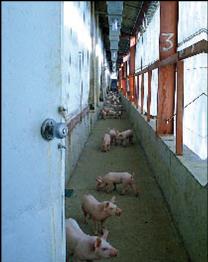Uruguay – potentially a strong pork producer

Uruguay, with its world-famous beef industry, harbours appropriate conditions for a thriving pork industry; meat expertise, good potential for grain production, and proximity to the major South American producers. So far, that’s been only theory. What are the country’s perspectives?
By Dr Rogério G.T. da Cunha and Luciana Martins
©
Looking at the country’s vast amounts of plains, Uruguay has good conditions for a thriving pork and/or poultry industry. It’s located right besides Rio Grande do Sul, the southern most Brazilian state, which cares for about one sixth of the Brazilian pork production. Considering the animal health situation, Uruguay is in a privileged position as well. Dr Ricardo Cochran Segundo, a Uruguayan veterinary, working for OPP, a Spanish veterinary consultancy agency, says: “Uruguay is free from the majority of the most serious diseases. There is no PRRS and Aujeszky’s Disease. Moreover, there have been no recent reports of FMD or influenza and PCV2 is present but it’s not a large problem. Therefore it is clear of most of the more problematic viral diseases.”
©
Ideal circumstances they seem – but reality shows that the country’s production is rather small, see Figure 1. According to data gathered by the Uruguayan Ministry of Animal Husbandry, Agriculture and Fisheries, the country’s total pig population counted 245,000 pigs in 2007. Uruguay slaughtered 297,300 animals in that year (of which commercially roughly 184,500 finisher pigs and 22,000 piglets), producing 21,000 tonnes of pigmeat. Some 11,000 imported tonnes completed the figure for a consumption of nearly 32,000 tonnes (9.7 kg/person/year). According to a survey in 2006, the country counted 2,808 commercial producing units. These figures do not add up to large numbers, since integrators, very large production units or coops have been lacking in Uruguay, Segundo explains. “Most producers are independent and small or medium, with or without a slaughtering plant. In fact, Uruguay has only two larger production units with over 1,000 sows. One of those is Pig Uruguay with 2,000 sows, the other being Granja La Familia with 1,500 sows. Overall, there are less than 10,000 sows on intensive and semi-intensive production. Also important is the Catelan unit, a small branch of a Spanish genetic company, which has close to 600 sows,” he points out. “Production is concentrated in the departments of Colonia, San José, Canelones and Salto.”
©
©
©
©
©
©
©
©
©
©
©
©
©
©
©
So, why does the pork sector not take off? Part of the explanation lies in the low domestic consumption, Segundo says. For most of the last decades, Uruguayans ate between 6-9 kg/person/year. This consumption is mostly from processed products – as is common in Brazil. “Besides”, Segundo adds, “there is no governmental stimulus for pork production and export. All policies are focused on the cattle sector, one in which the country has a long standing tradition and was able to build a positive international image.”
©
Prospects for the future
Different prospects exist for the near future of Uruguayan pork production. Forecasts by the Organisation for Economic Co-operation and Development (OECD) show a modest increase in per capita pork consumption, reaching over 11 kg/person/year by 2017. Production-wise, these figures foresee a growth too, but one that roughly follows domestic consumption, and not much more than this. The estimated figures in 2017 show a domestic production of over 36,000 tonnes, answering for about 70% of the country’s consumption in that year (around 50,000 tonnes). Therefore, Uruguay will keep on being a net pork importer, according to OECD’s predictions.
©
Segundo analysed the situation from a different perspective. He considered the potentialities of the country – and sees three different kinds of opportunities for potential investors. Firstly there is the growing demand for high quality products in a fairly new sector of the population. “Uruguayan population structure is slowly changing, mostly as wealthy tourism increases. In fact some regional tourists are starting to settle down for longer periods, up to three or four months per year,” Segundo said.
©
The second opportunity he sees relates to the high health status of the country and the regional agreements (Mercosur). “Overall this makes Uruguay an interesting country to establish a genetic nucleus, especially for selling embryos and semen to the region”, he concludes. Not forgetting the country is close to Chile and Argentina (the second and third major South American producers), and to the southern tip of the Brazil, the heart of this country’s important pork industry.
©
Lastly, there is the grain production industry, which, according to him, is growing fast and is able to produce corn and soy at competitive regional prices. Segundo: “A modern pig farm of the right size, between 1,250 and 5,000 sows, integrated with agriculture, could produce pork at very good costs.”
©
Uruguay background Uruguay is South America’s second smallest country, with a surface of roughly 176,000 km2 and just over 3 million inhabitants. The country has a sub-tropical to temperate climate, with a once prosperous economy and a high quality of life. Cattle husbandry, agriculture and tourism are fundaments of the country’s economy. Pork production in Uruguay has fluctuated around 20,000 tonnes for a long time – which is extremely low in comparison to its South American neighbours. The year 2003 was the worst in Uruguay’s history, reaching a low of just under 17,000 tonnes. This was due to a combination of several factors: the exchange rate to the Brazilian real, export surpluses and the 2001 crisis. Consumption-wise, pork ranked third among the country’s preference in the 1960s, well below beef and lamb. In the 1990s it went down to fourth place, as broilers gained popularity, probably due to low production costs. Pork recovered its third place as lamb/mutton consumption plummeted. As for pork trade, the country exported only negligible amounts over the years. In addition, it’s been importing 30-40% of its domestic consumption. “Uruguay is an importer mainly from Brazil, and a bit from Chile, since the price of the low cost cuts from Brazil is extremely cheap,” Segundo says. |
©
©©Source: Pig Progress Volume 25 nr©3











